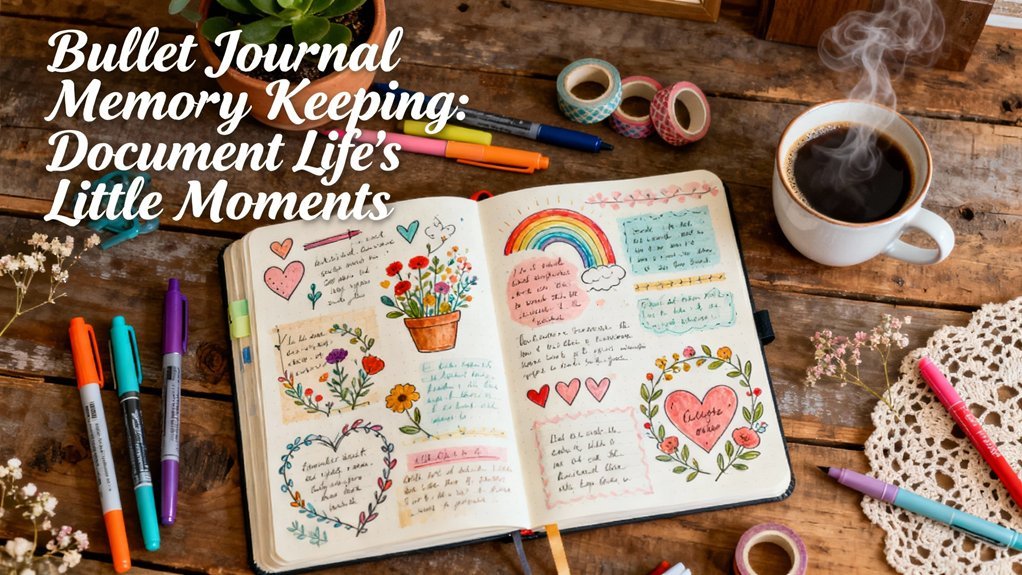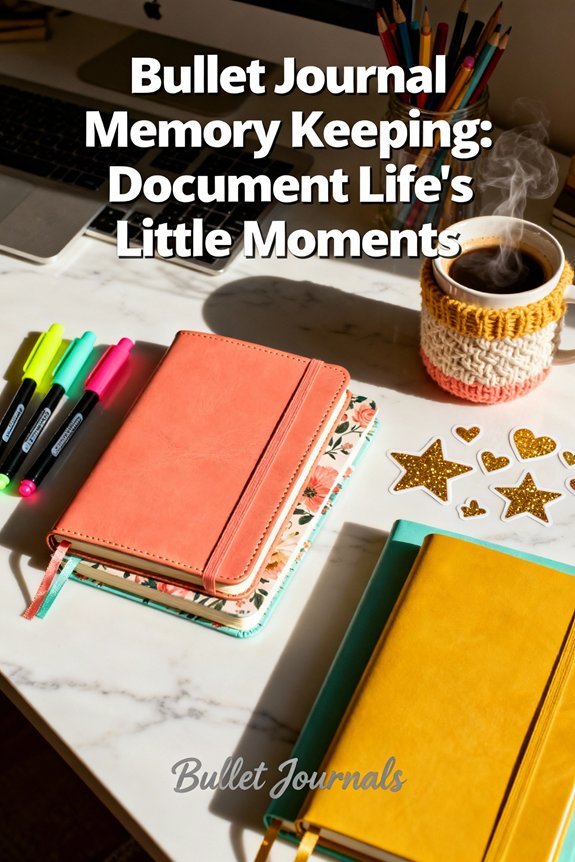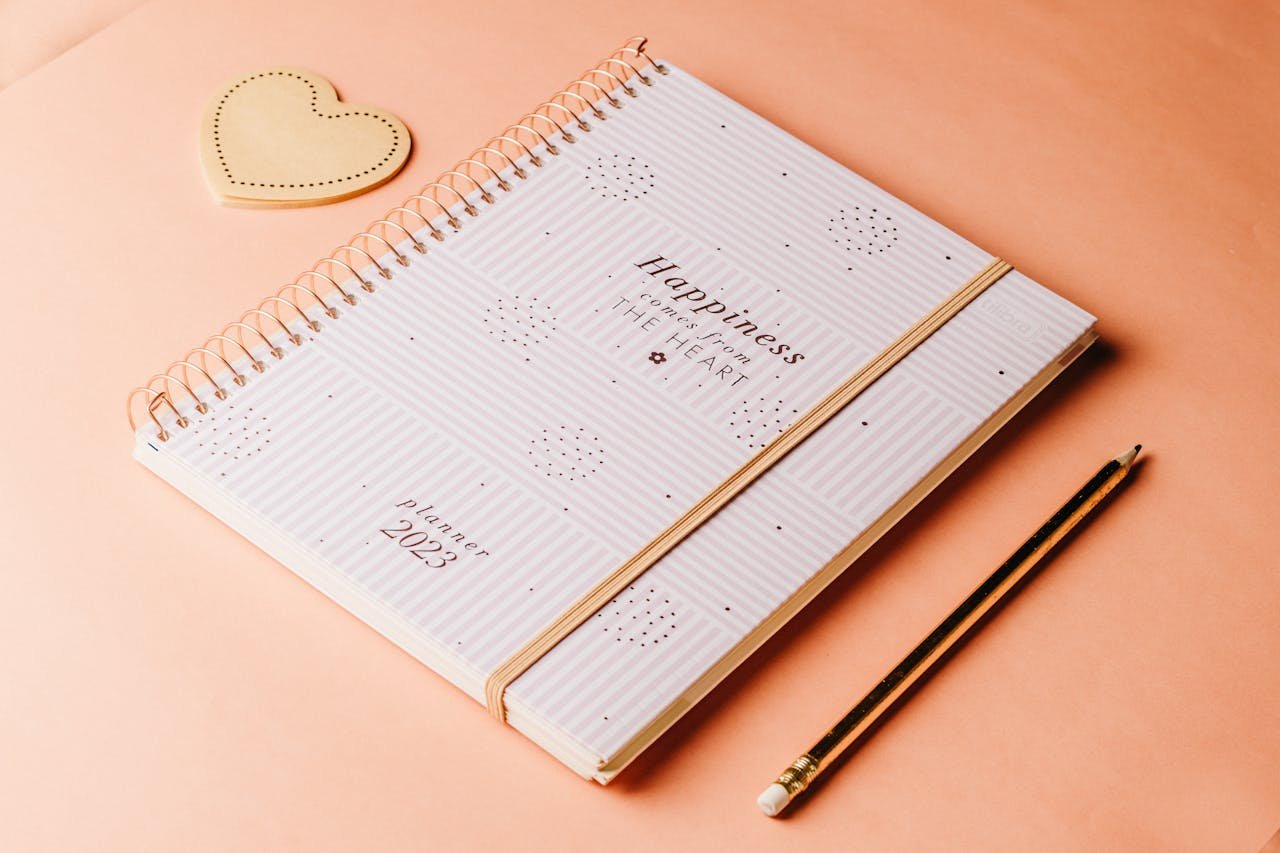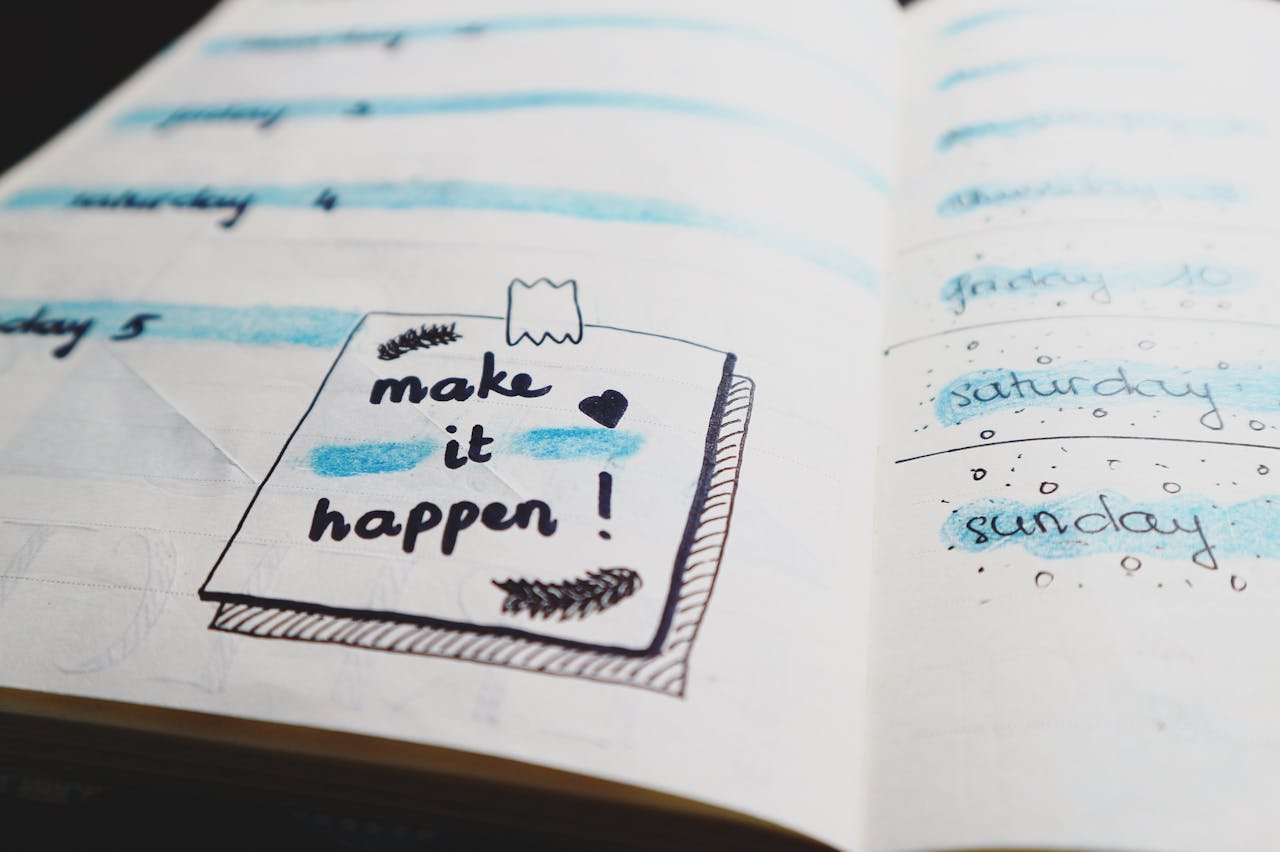Bullet journal memory keeping alters how you document life by using rapid logging with symbols, one-line entries, and visual icons instead of lengthy prose. You'll create daily logs for spontaneous observations, monthly spreads to consolidate highlights, and gratitude grids for visual appreciation tracking. Attach photos with washi tape, use transparent pockets for ticket stubs, and spend just 2-3 minutes daily capturing meaningful moments. This flexible system lets you skip days guilt-free while building a sustainable habit through structured weekly reviews and strategic habit tracking that reveals patterns you'd otherwise miss.
Key Takeaways
- Use rapid logging with symbols (bullets, dashes, circles) and one-line entries to capture daily moments in 2-3 minutes.
- Create visual memory spreads using sketches, color coding, and icons to organize highlights by theme or emotion.
- Attach physical mementos like photos, tickets, and washi tape directly to pages for tactile, three-dimensional memory keeping.
- Establish brief weekly and monthly reflection practices to identify patterns and consolidate meaningful experiences without lengthy prose.
- Focus on documenting emotionally significant moments rather than exhaustive archives, prioritizing authenticity over perfection.
What Makes Bullet Journal Memory Keeping Different From Traditional Journaling
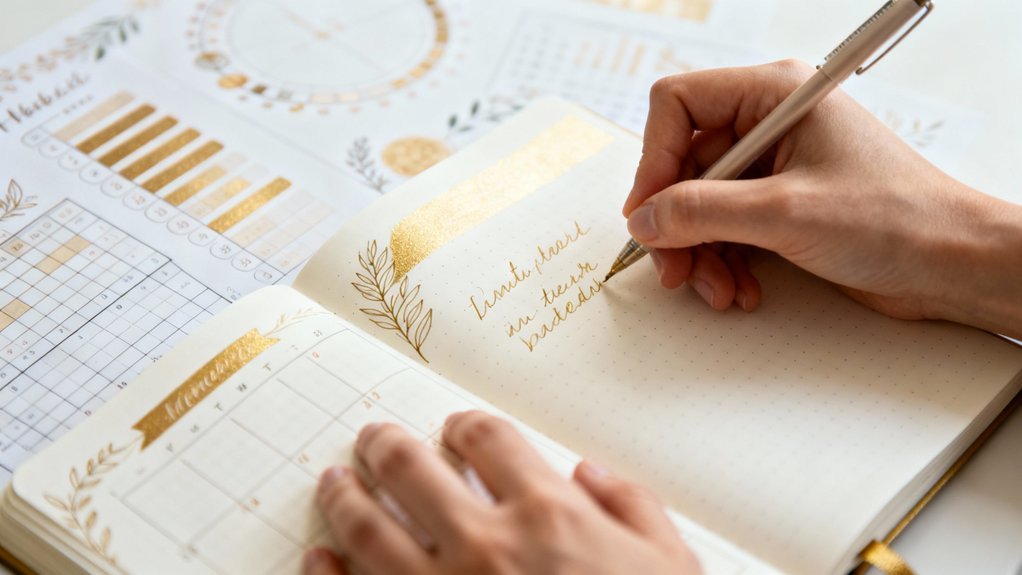
While traditional journaling focuses on writing lengthy prose about your day, bullet journal memory keeping changes how you capture and organize life's moments through rapid logging and visual systems.
You'll use symbols and short phrases instead of paragraphs, making memory journaling faster and more scannable. This method alters how you document experiences—bullets for tasks, dashes for notes, circles for events—creating a personalized shorthand that captures information efficiently.
The structure enables creative expression through collections, spreads, and trackers. You'll design pages that serve specific purposes: mood trackers, gratitude logs, or monthly highlights. Each element works together as an integrated system rather than disconnected entries.
You're not bound by daily writing commitments. Skip days without guilt, then return when inspiration strikes.
Bullet journaling frees you from daily obligations—engage when it feels meaningful, not because the calendar demands it.
Add photos, drawings, or ticket stubs alongside your rapid logs. This flexibility lets you innovate constantly, adapting your journal to match your evolving needs and preferences.
The method helps you track the past, organize the present, and plan the future through intentional documentation of what truly matters.
Essential Spreads and Layouts for Capturing Daily Moments
The daily log forms the foundation of your bullet journal memory keeping system, serving as your primary spread for capturing moments as they happen. Document spontaneous observations, conversations, and experiences using rapid logging symbols that change mundane entries into searchable memory spreads.
Create dedicated layout inspiration by designing these three essential spreads:
| Spread Type | Purpose | Update Frequency |
|---|---|---|
| Weekly Snapshot | Capture photo-worthy moments with quick sketches | Every 7 days |
| Monthly Memories | Consolidate highlights and patterns | End of month |
| Gratitude Grid | Track daily appreciation in visual format | Daily |
Structure your pages with intentional white space and consistent indexing. Use color coding to categorize memory types—personal growth in blue, relationships in green, achievements in gold.
Experiment with hybrid layouts that combine traditional bullet points with visual elements. Add small pockets for ticket stubs or polaroids. Your memory keeping evolves through testing different configurations until you discover what captures your life authentically.
Whether you're starting from scratch or refining your system, time management techniques integrated into your memory spreads help ensure you consistently capture moments without overwhelming your daily routine.
Quick Memory Logging Techniques for Busy Schedules
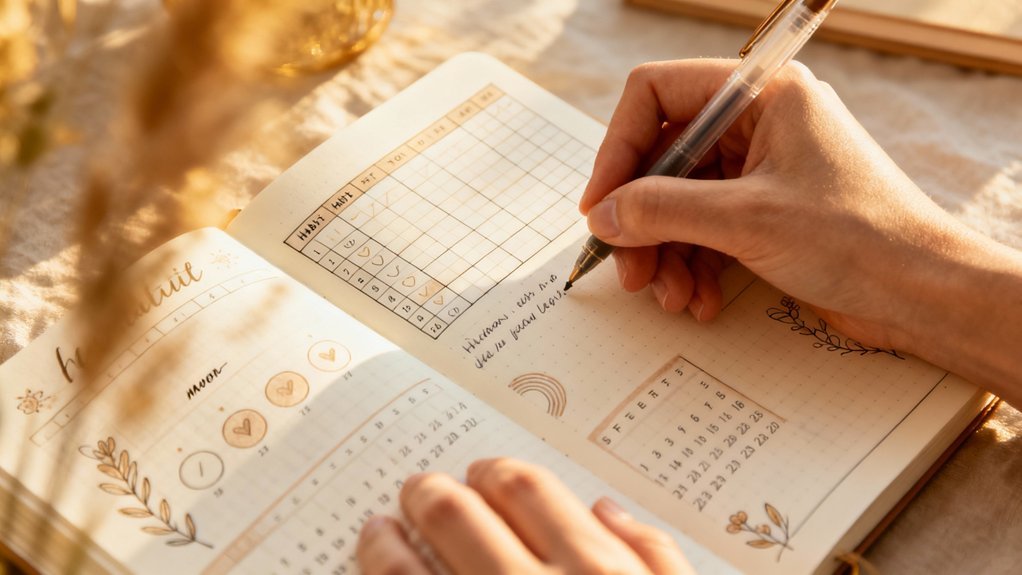
When time is limited, simplify your memory keeping by recording one-line daily entries that capture the essence of each day in a single sentence.
Pair these brief entries with visual icons and symbols—such as hearts for memorable moments, stars for achievements, or weather symbols for atmospheric context—to convey meaning at a glance.
This combination creates a scannable timeline that preserves your memories without demanding extensive writing sessions.
One-Line Daily Entries
Because maintaining a detailed journal feels impossible when your schedule overflows with commitments, one-line daily entries offer a practical solution that takes less than 30 seconds per day.
Create a dedicated page in your bullet journal with dates listed vertically. Each evening, record one significant moment using a simple sentence. Focus on highlight moments that captured your attention—a meaningful conversation, unexpected discovery, or small victory.
Structure your entries by rotating themes: Monday for daily gratitude, Tuesday for challenges overcome, Wednesday for lessons learned. This systematic approach eliminates decision fatigue while ensuring diverse memory capture.
You'll document authentic experiences without perfectionism blocking your progress. After months of consistent logging, you'll possess a compressed timeline of your year's most memorable moments, revealing patterns and growth you'd otherwise miss.
Visual Icons and Symbols
| Symbol | Memory Type | Quick Note |
|---|---|---|
| ☀ | Energy boost moment | “morning run” |
| 💡 | Insight gained | “project idea” |
| 🎯 | Goal milestone | “5K completed” |
| 😊 | Joy captured | “surprise visit” |
Draw icons in margins beside dates or integrate them into monthly spreads. You're building a visual language that changes dense paragraphs into instant recall triggers, making memory review simple during monthly reflections.
Creative Ways to Incorporate Photos, Tickets, and Mementos
Your bullet journal changes into a three-dimensional memory vault when you attach physical mementos directly to its pages.
Create miniature photo collages using corner mounts or washi tape—trim images to 1×1 inch squares for efficient space management. Attach ticket stubs with transparent pockets or glue sticks, positioning them chronologically alongside your daily logs.
Transform journal pages into compact memory galleries by mounting trimmed photos and ticket stubs alongside daily entries for space-efficient documentation.
Alter flat pages into tactile experiences by layering scrapbook embellishments: pressed flowers, fabric swatches, or postage stamps. Use envelope pockets for bulkier items—concert wristbands, fortune cookie messages, or coffee shop receipts.
Design a memory jar concept within your journal by dedicating spreads to collected treasures from specific events.
Implement strategic placement: position mementos near relevant journal entries to strengthen memory associations. Apply clear contact paper over delicate items for preservation.
Fold larger materials using accordion techniques to optimize space while maintaining accessibility. These physical anchors change standard documentation into immersive memory experiences.
Weekly and Monthly Reflection Practices That Actually Stick

Three strategic checkpoints convert sporadic journaling into a sustainable reflection system.
You'll build momentum by establishing Sunday evening reviews, mid-month assessments, and end-of-month in-depth evaluations. Each checkpoint serves distinct purposes in your time management framework.
| Checkpoint | Duration | Core Focus |
|---|---|---|
| Weekly | 10 minutes | Capture highlights, disappointments, lessons learned |
| Mid-Month | 15 minutes | Assess goal setting progress, adjust trajectories |
| Monthly | 25 minutes | Archive achievements, identify patterns, set intentions |
Start your weekly reviews by listing three moments worth remembering—no elaborate descriptions needed. Your mid-month check redirects energy toward goals that matter, eliminating activities that don't serve you. Monthly reviews reveal behavioral patterns you'd otherwise miss.
The innovation lies in brevity. You're not writing essays; you're creating data points. Set phone reminders for each checkpoint, treat them as non-negotiable appointments, and watch how consistent micro-reflections compound into profound self-awareness. Action breeds clarity, not perfection.
Overcoming Common Memory Keeping Challenges and Obstacles
Even when you've established solid reflection routines, three persistent obstacles will threaten your memory keeping practice: perfectionism paralysis, inconsistent documentation habits, and the overwhelming urge to record everything.
Combat these memory keeping challenges with tactical solutions. For overcoming perfectionism, implement the “good enough” rule—capture moments with bullet points instead of elaborate spreads. Your documentation doesn't need artistic merit to hold meaning.
Address inconsistent habits through time management strategies that work with your schedule. Set a five-minute daily timer for memory capture, making documentation non-negotiable yet achievable.
Tackle information overload by simplifying documentation. Create a filtering system: record only moments that triggered genuine emotion or taught you something valuable. You're curating memories, not creating an exhaustive life archive.
When obstacles emerge, return to your core purpose. You're not pursuing perfection—you're preserving perspective. Every imperfect entry you complete outweighs the perfect spread you never start.
Building a Sustainable Memory Documentation Habit

Sustainable memory documentation requires strategic habit formation, not motivation or willpower alone. You'll need structured systems that integrate smoothly into your existing routines.
Implement habit tracking pages to monitor your documentation consistency. Track which memory-capturing methods you're actually using versus abandoning. This data reveals your authentic patterns.
Use journaling prompts strategically when creativity stalls. Deploy them as activation tools, not crutches.
| Frequency | Time Investment | Documentation Method |
|---|---|---|
| Daily | 2-3 minutes | Quick bullet memories |
| Weekly | 10-15 minutes | Photo integration + captions |
| Monthly | 20-30 minutes | Memory spread compilation |
| Quarterly | 45-60 minutes | Pattern analysis review |
| Yearly | 90+ minutes | Archive system optimization |
Stack memory documentation with existing habits. Capture moments during your morning coffee ritual or evening wind-down. Anchor the practice to established behaviors rather than creating isolated tasks. Your bullet journal becomes a living archive when documentation evolves from obligation into automatic practice.
Frequently Asked Questions
Can I Start Bullet Journal Memory Keeping Mid-Year or Mid-Month?
You can absolutely start bullet journal memory keeping anytime—there's no need to wait for January 1st or the first of the month.
Here are starting tips: grab any notebook, date your first page with today's date, and begin documenting.
The mid year benefits include capturing memories right now rather than losing them while waiting.
You'll create momentum immediately and develop your unique system through experimentation.
Innovation happens when you start, not when conditions are perfect.
What Should I Do With My Old Journals Once They're Filled?
Store your filled journals using creative storage solutions like labeled archival boxes, decorative bins, or dedicated bookshelf space.
You'll preserve your memories while keeping them accessible. If you're ready to part with certain entries, explore journal recycling ideas: photograph meaningful pages for digital archives, repurpose artistic spreads into wall art, or donate journals with reusable techniques to beginners.
Convert outdated content into scrapbook materials. You're creating a personalized memory system that evolves with your needs.
How Do I Handle Private Memories I Don't Want Others Reading?
Create coded symbols, create designated pages, create memory vaults—you'll protect what matters most.
Designate private entries with unique markers only you'll recognize. Use removable pages for sensitive content, storing them separately in a secure location.
Develop your own cipher system or write in obscure languages. You can also maintain dual journals: one for shareable moments, another exclusively for confidential reflections.
Consider digital encryption apps that complement your analog system, giving you complete control over who accesses your intimate memories.
Should I Keep Separate Journals for Different Areas of My Life?
You'll find success with either approach—experiment to discover what works best.
Start by testing different journal types: a unified system versus separate notebooks for work, personal life, and creative projects.
Try both organizational strategies for one month each. Track which method you actually maintain consistently.
Many groundbreaking memory-keepers prefer one integrated journal with color-coded sections or index tags, allowing cross-referencing between life areas while maintaining focused clarity when needed.
What's the Best Way to Transport My Bullet Journal While Traveling?
Your bullet journal's your creative command center—protect it fiercely.
Invest in a hardcover protective case with elastic closure for ultimate journal protection.
Add a waterproof sleeve inside your carry-on's main compartment, never checking it.
Here's your innovation: attach a slim pouch to store pens and washi tape together.
These travel tips convert chaos into control.
Snap photos of essential pages before departure as digital backup.
You'll arrive ready to document adventures effortlessly.
Conclusion
You've learned the systems—now put pen to paper. Start with just one spread this week, whether it's a daily log or photo pocket. Remember: Rome wasn't built in a day, and neither is a meaningful memory-keeping practice. Set your timer for five minutes each evening, capture what matters, and watch your collection grow. Don't overthink the perfect layout. Open your journal, document today's moment, and begin building your archive of everyday life.

